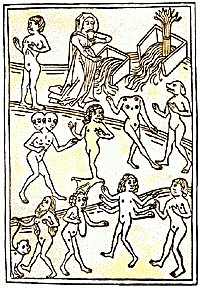
COSMIC UNITY AND THE ANOMALOUS OBJECT
 The categories which appeared to structure the world were not viewed as absolute:
according to the Neoplatonic and Hermetic traditions prevalent in the
sixteenth-century, the ultimate macrocosm was a spiritual, indivisible whole,
containing but not subject to the categories of the material world. As Frances
Yates explains, summarizing from the Renaissance treatise Picatrix, a popular
hermetic text, "The primal truth is not a body, but it is One, One Truth, One
Unity. All things come from it and through it receive truth and unity in the
perpetual movement of generation and corruption. There is a hierarchy in things,
and lower things are raised to higher things; and higher things descend to lower
things. Man is a little world reflecting the great world of the cosmos, but
through his intellect the wise man can raise himself above the seven heavens."
(Giordano Bruno and the Hermetic Tradition, p. 51)
The categories which appeared to structure the world were not viewed as absolute:
according to the Neoplatonic and Hermetic traditions prevalent in the
sixteenth-century, the ultimate macrocosm was a spiritual, indivisible whole,
containing but not subject to the categories of the material world. As Frances
Yates explains, summarizing from the Renaissance treatise Picatrix, a popular
hermetic text, "The primal truth is not a body, but it is One, One Truth, One
Unity. All things come from it and through it receive truth and unity in the
perpetual movement of generation and corruption. There is a hierarchy in things,
and lower things are raised to higher things; and higher things descend to lower
things. Man is a little world reflecting the great world of the cosmos, but
through his intellect the wise man can raise himself above the seven heavens."
(Giordano Bruno and the Hermetic Tradition, p. 51)
The categories of the visible world of matter were merely limited manifestations of a single transcendent principle. Therefore, aberrations and anomalies, objects which occupied the margins of categories and transgressed their boundaries were prized as signposts to a higher reality. These were the true "objects of knowledge" which revealed to the collector the invisible unifying principles of the macrocosm.
One such item included in our Curiosity Cabinet was a large Gypsum crystal in the
shape of a sword, included in our weapons display. Its resemblance to a sword--a
man-made artifact--meant the object crossed one of the greatest boundaries in
conceptualizing the world, between the artificial and the natural.
 |
{Essays} {Gallery} {Microcosms} |
 |